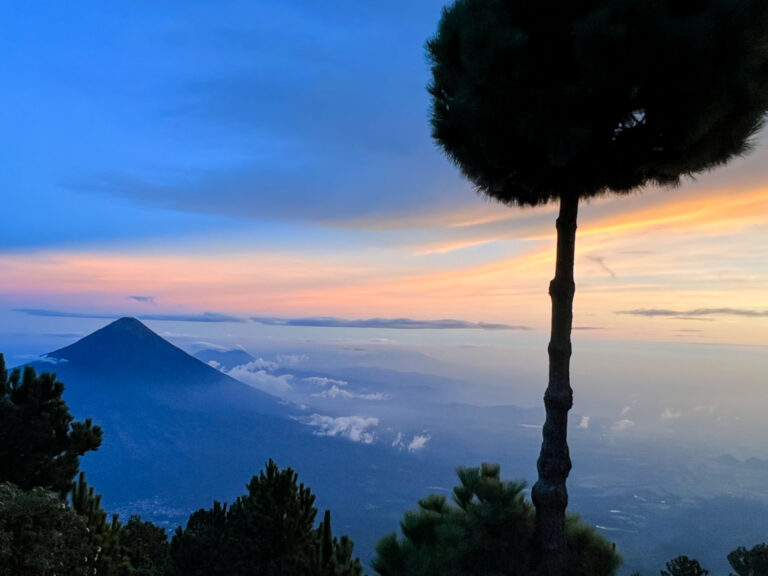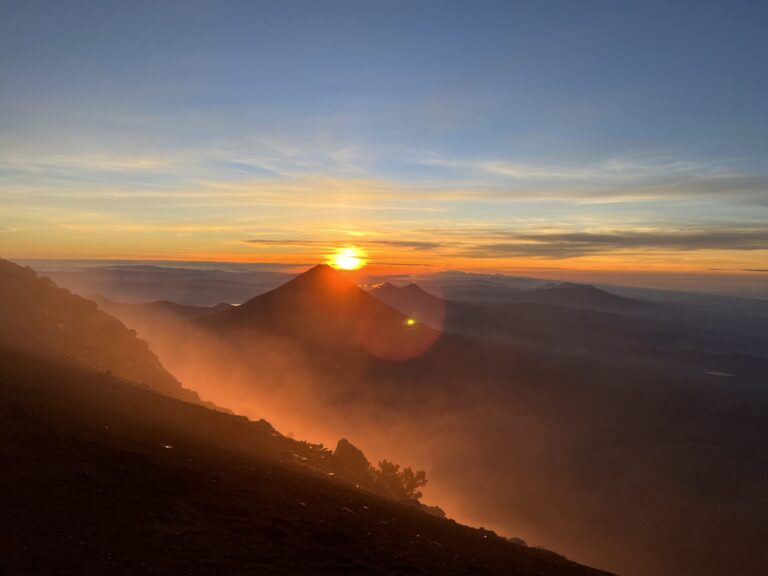Hiking Volcanoes in Guatemala: 6 Must Do Volcano Climbs
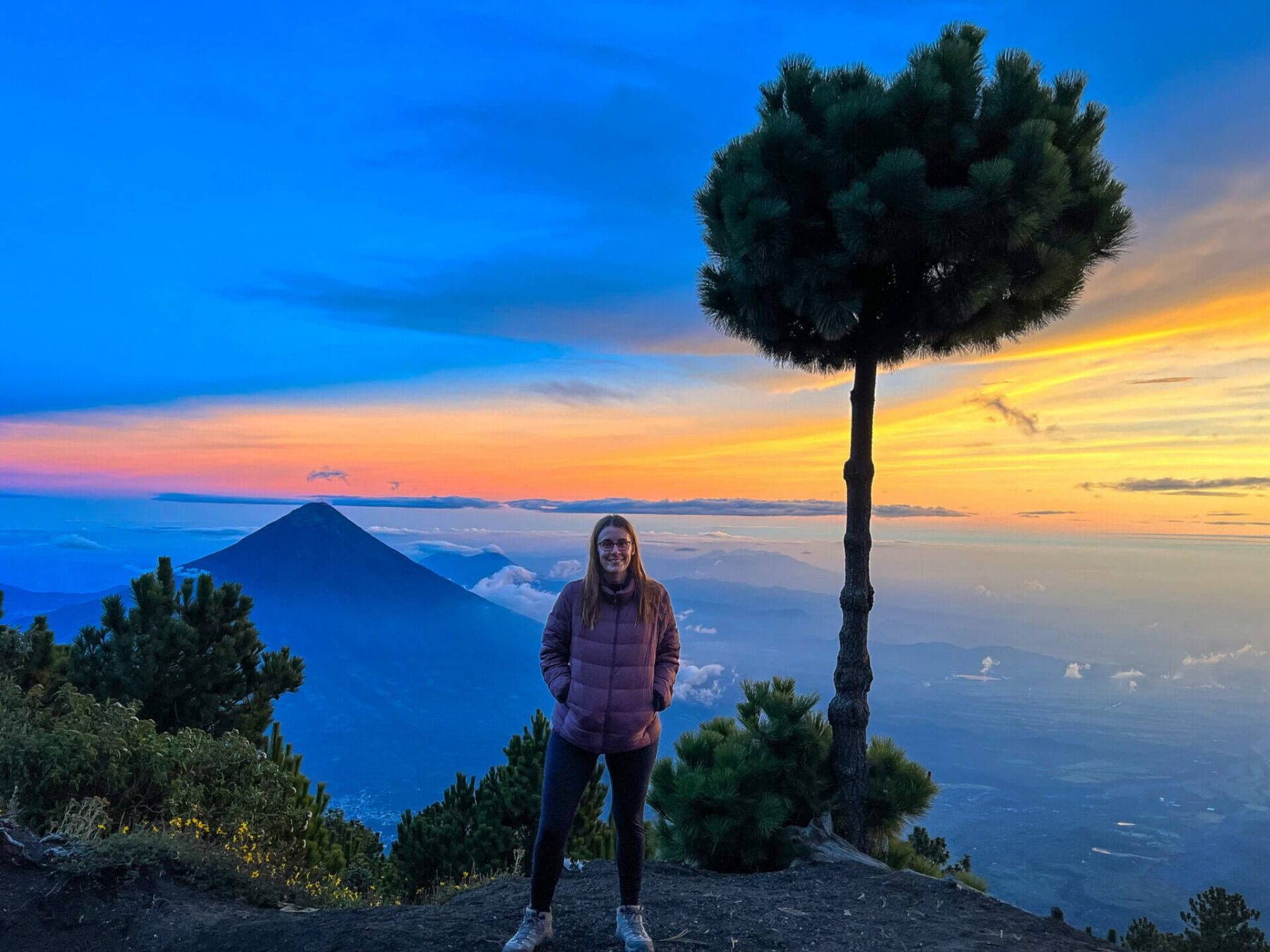
When planning my first ever backpacking trip, one country was at the top of my list – Guatemala. My friend had visited the year before and showed me photos of Guatemala’s most famous attraction, the erupting Fuego. Seeing the mighty Fuego erupt quickly made its way to the top of my bucket list, and I knew it was something I HAD to do.
Guatemala is one of the most beautiful countries I have ever been to. With lush jungles, incredible lakes, and over thirty volcanoes, the landscape is one of the most diverse and magnificent in all of Latin America.
My backpacking trip around Guatemala turned out to be a true adventure! Not only did I see Fuego, but I also hiked several of the country’s other famous volcanoes. I spent a week with Much Better Adventures, completing five hikes before tackling a couple of extra ones.
In this guide, I’ve shared six of the best hikes in Guatemala, including the infamous Acatenango, the active Pacaya and the breathtaking Tajumulco.
The best volcano hikes in Guatemala
The Pacaya Volcano
Location: Near Antigua
Distance: Around 3.5 miles / 5.6km
Elevation change: 400 metres / 1300ft
How to visit: arrange a tour through your accommodation or book online here
The Pacaya Volcano is one of the most famous volcanoes in Guatemala, and it’s a popular day trip from Antigua.
The active volcano last erupted in 2021, and for a while, you could get close to the red-hot lava. While the lava flow has now stopped, you can still walk through the lava field, see steam coming out of the crater, and get epic views of the area.
One of the most extraordinary things about this spot is that the lava is still warm in some places. You can roast marshmallows, melt chocolate and even cook pizza! Our guide had to warn us not to keep our shoes in one spot for too long as they could start to melt.
To visit Pacaya, you must have a guide, so your best option is to book a tour through your accommodation or online.
The tour begins with a drive from Antigua to Pacaya through the fantastic Guatemalan scenery. You can also catch your first glimpses of Fuego.
From the drop-off point, it takes around 60-90 minutes to get up to the main lava field. From there, you’ll walk across the harsh lava to a lunch spot. You can also try roasting marshmallows or even cooking a pizza.
Walking on the lava rock is quite hard work. It’s often loose and can be sharp on the feet. But overall, the hike isn’t too challenging and is doable for anyone with a reasonable fitness level. It’s the easiest hike on this list and much easier than Acatenango. Just be prepared for a bit of an uphill slog.
Tip: Take some cash with you to tip your guides. A local family also sold jewellery made from the lava.
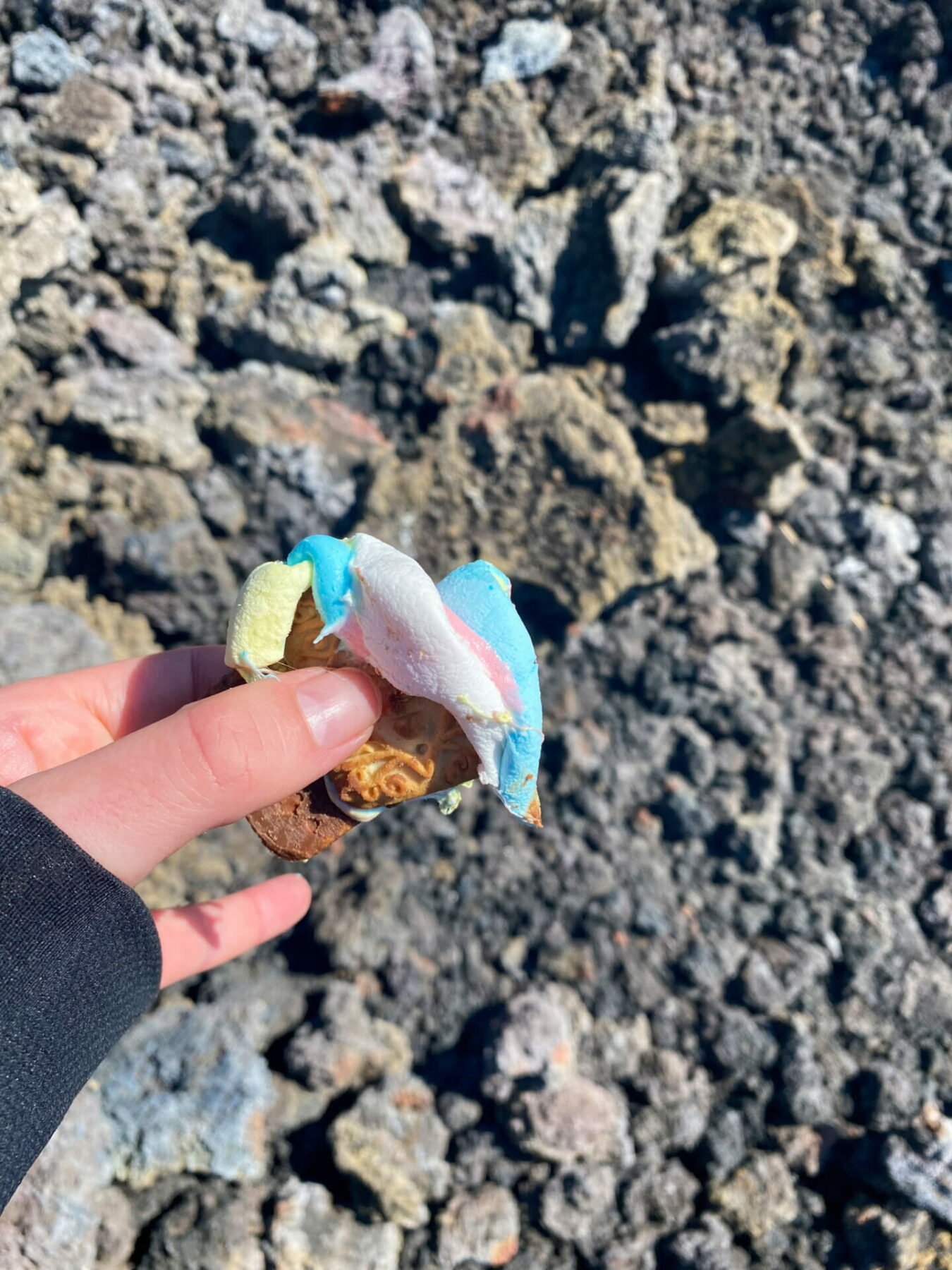
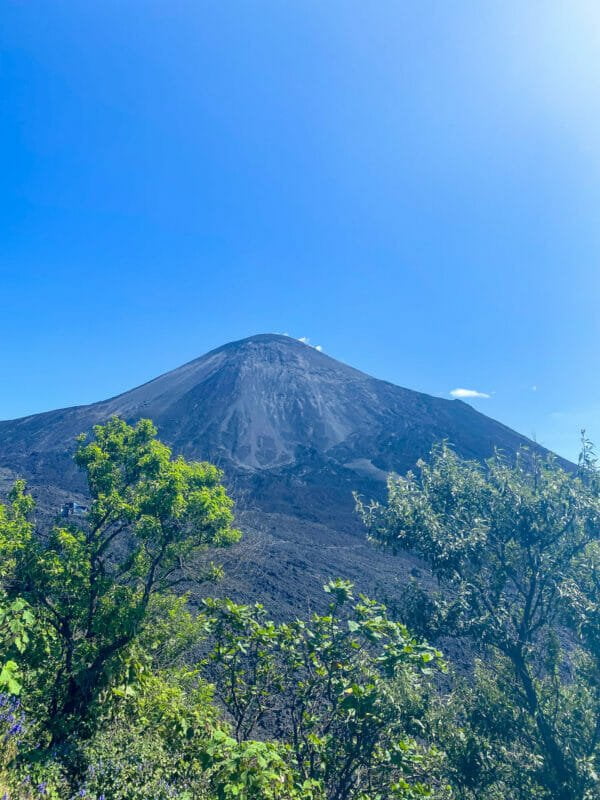
Acatenango Volcano (to watch Fuego Erupt)
Location: Near Antigua
Distance: 8.5 miles (14km)
Elevation gain: 1600 metres / 5200 feet
How to visit: arrange a tour through a local tour operator or your accommodation
The overnight hike up Acatenango is the most famous volcano hike in Guatemala and one of the best things to do in the country. It was the main reason I wanted to visit Guatemala.
What’s so special about this hike, you ask? Imagine watching the sunset over volcanoes at 12,000 feet above sea level. Then, as the sky turns black, the mighty Fuego sends lava and ash soaring into the sky. Well, that’s precisely what this is. Not to sound dramatic, but it’s a life-changing experience.
The hike starts with a 6 to 8-hour hike up Acatenango to base camp. This part of the hike isn’t exactly spectacular. You’ll begin by walking through farmland and then up through a forest. This is a highly challenging walk. It’s not technical, but it’s very steep and feels never-ending.
Once you’re above the trees, you’ll be pleased to hear the hike flattens out as you make your way to base camp.

The base camp is about 3,600 metres (12,000 ft) above sea level. It boasts magnificent views of Guatemala, including the star of the show – the erupting Fuego volcano. The Fuego volcano is only about 1.5 miles (2.5km) from Acatenango, so you have a front-row seat to watch the show. Fuego consistently erupts every 10-15 minutes, throwing lava and ash into the atmosphere.
You can see it during the day, but the real magic begins after sunset when the sky turns dark. This is when the red of the lava really shows. The first time it happened was truly incredible, and the whole base camp cheered.
After watching the eruption, the idea is to sleep before climbing to the summit of Acatenango the following morning for sunrise. But you’ll be lucky to sleep with the sound of the nearby Fuego erupting.
At around 4am, it’ll be time to start the final push to the summit. This was the hardest part of the climb for me. A lot of the track is ash, and it’s VERY hard to walk on. Keep pushing on – I promise it’s worth it.
Once you reach the summit, you’ll be rewarded with full panoramic views and one of the best sunrises I’ve seen in my entire life. I don’t have words to describe it.
The hike is no easy feat; it’s challenging, especially when contending with the altitude. However, you don’t need to be an experienced hiker to do this track. You’ll be fine if you have a good fitness level. Honestly, if there’s one hike you do in Guatemala, make it Acatenango.

The Santa Maria Volcano
Location: Quetzaltenango
Distance: 5 miles (8km)
Elevation gain: 1200 metres (4,000 feet)
How to visit: arrange a tour through a local tour operator or your accommodation (you can do it by yourself, but it’s not recommended)
Next up on this list of the best volcano hikes in Guatemala is the Santa Maria Volcano. This volcano is near the town of Quetzaltenango, about a 3-hour drive from Antigua.
I’d never heard of this volcano, but it’s a great hike! On a clear day, you can even witness the steaming crater of Santiaguito volcano.
While the hike is beautiful, I can’t say it’s my favourite. The scenery doesn’t quite compare to the other volcanoes on this list, and the trail was covered in litter. To be fair, I did the hike on a cloudy day in poor weather, so I didn’t exactly have the best conditions.
There are also some safety concerns about hiking the Santa Maria volcano. Many reviews will tell you it’s okay to hike without a guide, but there have been numerous occasions when tourists have been robbed on the volcano. It’s highly suggested that you hire a local guide to prevent this from happening.
The hike itself takes between six and eight hours. It’s a long walk up through farmlands and a forest. The ground can be very slippery after it’s rained (I found out the hard way). However, it’s nothing overly challenging.

The Tajumulco Volcano (Central America’s highest point)
Location: San Marcos
Distance: 7.7 miles (12km)
Elevation gain: 4200 metres (13,800 feet)
How to visit: To see the sunrise, you’ll need to camp overnight. It’s recommended that you hire a local guide for this. You can also do the hike in a day.
Tajumulco is one of my all-time favourite hikes! Watching the sunrise from the peak of the Tajumulco volcano was one of the most spectacular sights in all of my travels.
Tajumulco is Central America’s tallest mountain, sitting at 4200 metres (13,800 feet) in elevation. It’s an excellent hike in Guatemala, but few people seem to know about it.
Thankfully, reaching the summit is easier than it sounds, as the total elevation gain is ‘only’ 1,100 metres (3,600 feet)—a lot less than the Acatenango hike.
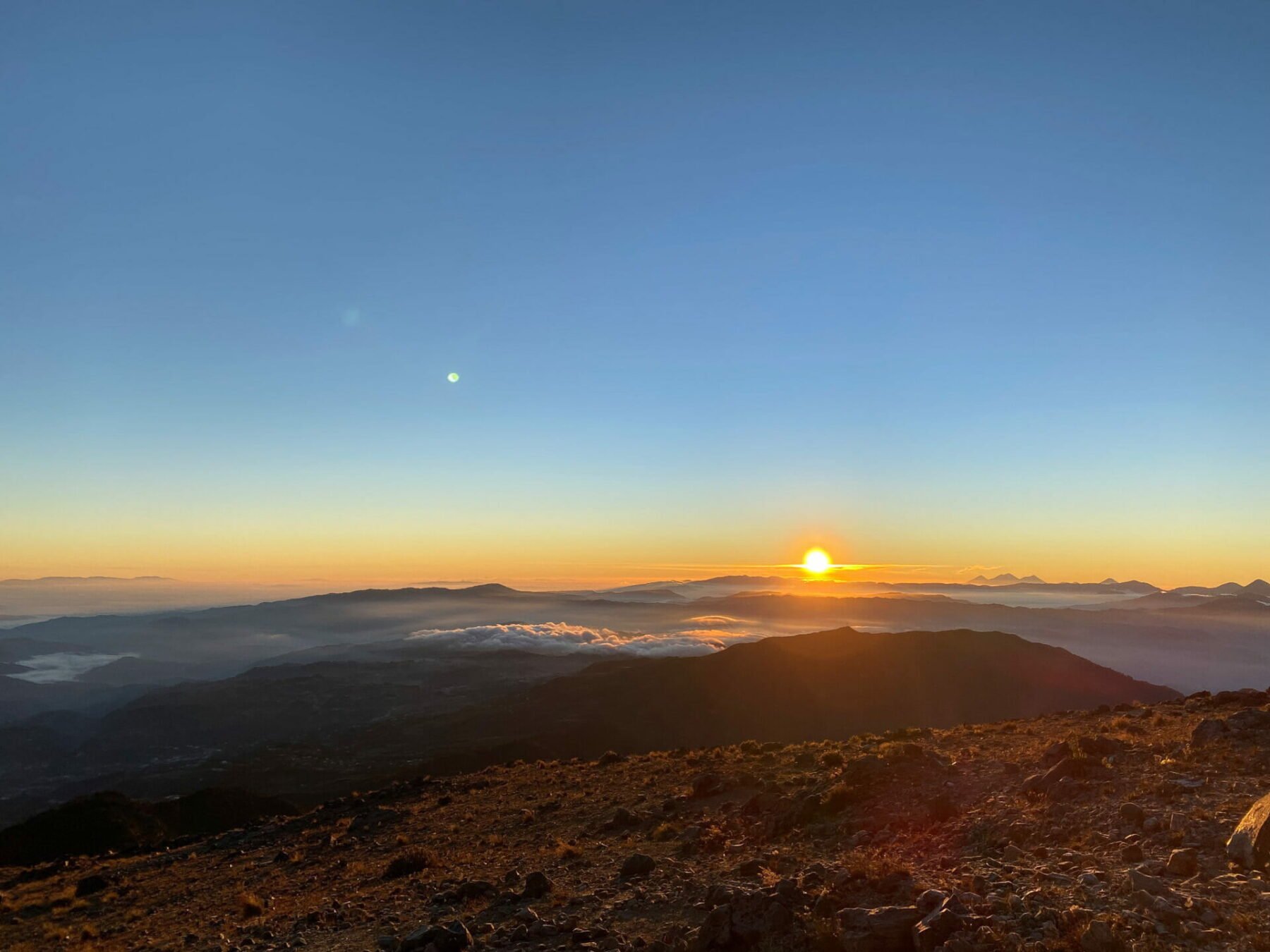
Having said that, the hike is still hard work, as you’ll be contending with the high altitude and altitude sickness. This is the hike I found the most challenging. I was exhausted and, for some reason, struggled with the altitude a lot more on this hike than others.
There are two options for climbing the Tajumulco volcano: You can do it in one day or camp overnight and head to the summit for sunrise.
I did the latter, and wow—it was magnificent. There was something magical about standing on the highest point in Central America and watching the sunrise.
The hike itself isn’t too bad. It’s pretty steep at times, but it is a fairly consistent climb up to the base camp, which takes about four hours. This was some of the most breathtaking scenery I’ve ever seen.
From base camp, you’ll need to scramble up some rocks for around an hour to reach the summit. I didn’t find this too difficult, even in the pitch-black.
From the summit, you can see both Guatemala and Mexico. It felt like we were on top of the world. It truly is a spectacular hike.
I recommend joining a group or hiring a guide for the hike.

The San Pedro Volcano
Location: Lake Atitlan
Distance: 5 miles (7km)
Elevation gain: 1200 metres (4,000 feet)
How to visit: organise through your accommodation. It’s highly recommended to have a local guide.
My final volcano hike in Guatemala was the San Pedro volcano at the magnificent Lake Atitlan. The hike gives you breathtaking views of the lake and surrounding volcanoes and mountains. It’s beautiful!
I did this hike at the end of a long week of hiking, so it’s safe to say I was exhausted. Even so, I didn’t find the hike overly challenging.
It’s about a five-hour return trip with a relatively consistent but steep incline. Although the trail is not difficult, it’s advised to take a guide. There have been reports of bandits on the trail who rob tourists, but when local guides are around, this generally doesn’t happen. We had two police officers with us on the trail.
The trail starts by weaving through farmland before beginning the uphill push through the forest. At the top, there are some rocks to rest on and admire the views of Lake Atitlan.
There is an entrance fee for the hike of Q100 ($13 USD).
If visiting Lake Atitlan, consider adding the San Pedro volcano hike to your itinerary.

Chicabal Volcano
Location: Quetzaltenango
Distance: 4.7 miles (7.6km)
Elevation gain: 650 metres (2100 feet)
How to visit: hire a local guide
The Chicabal Volcano is another shorter volcano hike in Guatemala. It is an inactive volcano in the Guatemalan highlands. The trail takes you to a mystical lagoon at the top of the volcano.
Sadly, I didn’t have time to do this hike, but there is here’s a guide on hiking the Chicabal volcano.
Bonus: Don’t miss the famous Indian Nose hike in Lake Atitlan. Although not a volcano, it offers the most magnificent sunrise views.

A review of my tour with Much Better Adventures
As much as I love hiking alone, I’m not sure I’d recommend it in Guatemala. For the most part, you need a guide to enter the hiking areas. But even when you don’t, many of the trails are often in secluded areas and known to be potentially dangerous.
This is why I chose to do most of my hikes with Much Better Adventures. They’re one of the best small-group tour operators, and their Guatemala hiking trip ticks off most of the volcanoes on this list.
There are so many benefits of group tours, but for me, the best part is that they’re a great safety net. Not only are the local guides there to help keep you safe, but if something goes wrong, the tour operator is there to help.

I’m so glad I chose to do my hikes with Much Better Adventures. Many of the hikes are off-the-beaten-path, and as a solo traveller in Guatemala, I don’t think I would have done them unless I was on this tour.
Whether you join the tour or do it yourself, climbing Guatemala’s colossal volcanoes is a great way to get a real feel for Guatemalan culture and life. The volcanoes on the list will take you off the main tourist route and immerse you in Guatemalan culture. It’s a beautiful country, and there is so much to explore.

